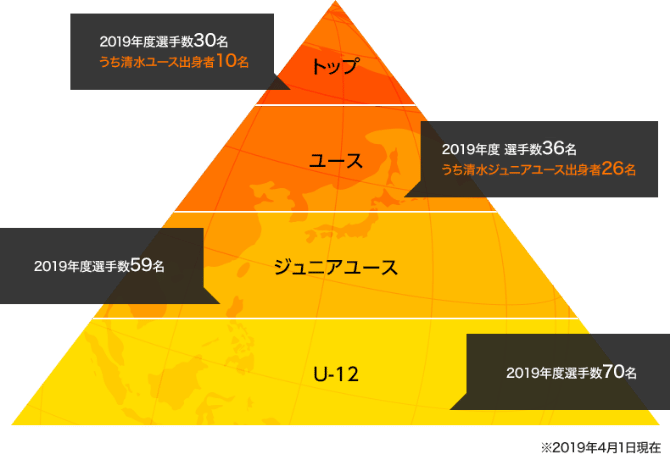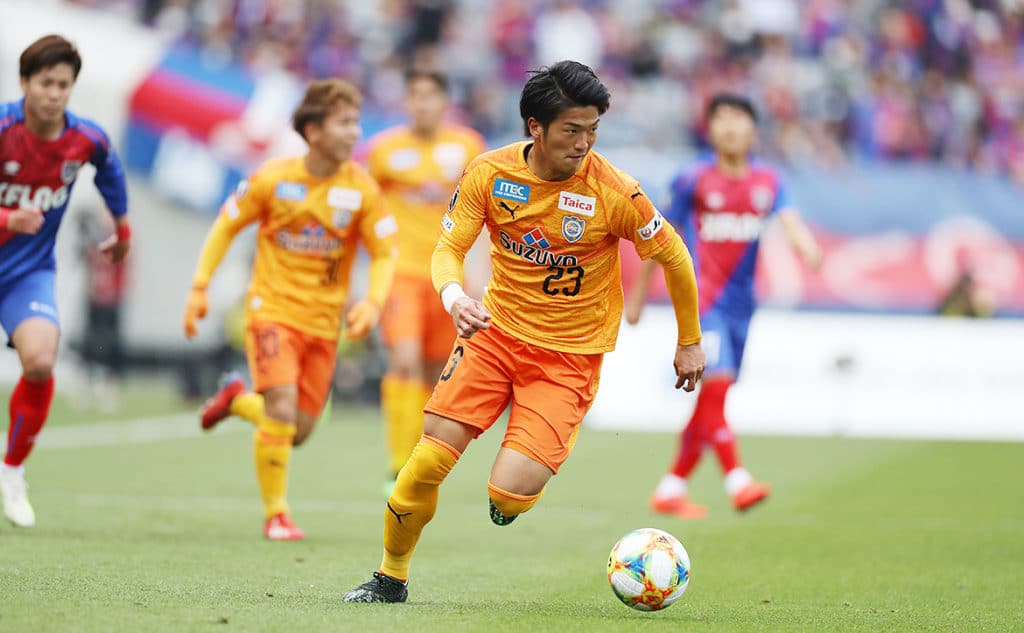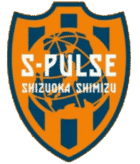Shimizu S-Pulse Tryouts
Shimizu S-Pulse (清水エスパルス, Shimizu Esuparusu) is a professional Japanese football club. Located in Shimizu-ku, Shizuoka, Shizuoka Prefecture, S-Pulse currently competes in the J1 League.
Shimizu S-Pulse Youth Development System
Academy
The youth (high school age / type 2) and junior youth (junior high school age / type 3) teams, which are the training organizations of Shimizu S-Pulse, were founded in April 1993. In April 2015, we established a junior (elementary school age / type 4) team to further enhance the training environment.

We play an important role of “cultivating players who can play an active role in the top team in the future” and provide high-quality training in a fulfilling environment. In addition to strengthening and nurturing with a consistent guidance system that connects to the top teams at the top, we are also focusing on human development through soccer.
It is unique to clubs that practice participation and game participation in the above categories are frequently performed depending on individual abilities. At S-Pulse, junior youth players participate in youth practice, and youth players participate in top team practice.
Successful player training through consistent guidance
With the ultimate goal of developing players who will play an active role in the top team, we will provide consistent guidance in each age group and category from junior (U12) to youth (U18) including grass roots.
Successful human education through sound education
Human beings who grow up as S-Pulse players and live with soccer Aiming for a balance between academics and soccer, human beings who can contribute to society in the future, including greetings and etiquette, independent and responsible human beings Eating, sleeping, resting, etc. A person who can manage A person who has a spirit of fair play, is humble, sincere, and can thank others.

Frequently Asked Questions (FAQ)
A: Youth is composed mainly of players who have been promoted from junior youth, but since 2000, we have been selecting and responding to the discovery and acquisition of new players. The selection is held every year in late August for first-year high school students.
Junior Youth conducts a selection every year from September to November for first-year junior high school students.
U-12 conducts a selection every year from December to February of the following year for fourth graders.
Basically, we do not recruit other grades in all categories. Details will be announced as soon as the selection schedule is decided.
A: Youth and junior youth are mainly practicing at Suzuyo Miho Ground (2945-1 Miho, Shimizu-ku, Shizuoka City). It is an artificial turf ground on the way to Miho ground, which is a practice field for S-Pulse.
In addition, youth is renting the Shizuoka City Hebitsuka Ground (Hebitsuka, Shimizu-ku, Shizuoka City), and Junior Youth U-13 is practicing by renting the Shizuoka Seikoin Junior and Senior High School Ground (Oshika, Suruga-ku, Shizuoka City). Shizuoka Seikoin Ground also uses U-12 Shimizu. U-12 Mishima is practicing at S-Pulse Dreamfield Sunto (Shimizu-cho, Sunto-gun).
Basically, U-18 and 15 practice 6 times a week, U-14 practice 5 and 6 times a week, 13 practice 5 times a week, and U-12 practice 4 and 5 times a week. The practice time per day is about 2 hours.
A: There is Shimizu S-Pulse Hijiriisshiki Dormitory. Youth players from outside the prefecture will move into the dormitory. Young players from the top team also live in this dormitory, and you can promote mental independence by living together.
A: Basically, for youth and junior youth, a team bus will pick you up at the ground. (There are days when we will meet locally.) Boarding locations include Hijiriisshiki Clubhouse, JR Shimizu Station, and JR Kusanagi Station. You are responsible for the round-trip transportation costs from your home to the bus stop. When U-13 practices at Shizuoka Seiko Gakuin Ground, or U-12 asks the family to pick up and drop off.
A: Please check the schedule before you come. Please note that the schedule is subject to sudden changes. There is a parking lot in the practice area, but the number is limited (especially on weekends and games).
Academy Selection Information
Additional recruitment/selection information can be found by clicking here.
EXPLORE MORE CLUBS!
Explore more professional clubs by continent.
History
The administrative headquarters are located in the Shizuoka Prefecture, which is known as the “football kingdom” in Japan. Shizuoka has a long history of being a powerful region for football in Japan. The prefecture is particularly well-known for the high level of success that its high school teams have achieved on a national level, as well as the large number of players for Japan’s national team that have emerged from Shizuoka over the years.
As a matter of fact, the Shizuoka prefectural police force has adopted an anthropomorphic football as its official mascot. The west of the prefecture was already home to the company team of Yamaha Motor Corporation, who competed in the Japan Soccer League and would subsequently go on to establish Jbilo Iwata. Despite this, it was considered that there was room for another team to serve the football-hungry population in the area.
An earlier attempt had been made in the 1970s with the local club that belonged to Nippon Light Metal Corp. and temporarily competed in the JSL Division 2 under the name Hagoromo Club. During this time, the club was known as the Hagoromo Club. At the beginning of the 1990s, the professional league was established, which sparked the idea of forming a team to both sign and represent the local footballing talent in the area. This idea was fostered by the arrival of the professional league.
Club Formation
In the beginning of 1991, Shimizu S-Pulse was originally known as Shimizu FC and was founded with the support of local residents and businesses. This was the beginning that set them apart from the other founding clubs of the J.League, all of which were former company teams that had transitioned into the professional ranks.
Shimizu S-Pulse became the club’s official moniker just two months after it was established as a separate entity. The name “S-Pulse” comes from a combination of the letters “S” for Shizuoka, “Shimizu,” “Supporter,” and “Soccer,” and the word “Pulse” from the English language. It refers to the collective energy of all of the people who cheer for the team. On February 4, 1991, the S-Pulse were granted permission by the J.League to participate in the newly formed professional league that was scheduled to begin play the following year.
On July 4, 1992, the club faced off against Gamba Osaka for the first time ever. This date is commemorated as the club’s memorial birthday and is known as the “first game.” The contest was held at Osaka’s Nagai Stadium, which is located in Osaka. On September 5, 1992, the club played its first competitive game in the League Cup against Nagoya Grampus at the Mizuho Athletic Stadium. The game resulted in a loss for the club by a score of 3–2.
Almost immediately after that, on September 9, S-Pulse made their competitive debut at Nihondaira Stadium, where they defeated Yokohama Marinos by a score of 2–1. Mitsuzawa Stadium was the location of S-first Pulse’s ever league game, which took place in May 1993 and was an away match against Yokohama Flügels. Flügels won 3–2. On May 19, of the same year, the club’s first home league game resulted in a victory over Sanfrecce Hiroshima by a score of 2–1.
Professional football
After being granted permission to play in the J.League, S-Pulse competed in the first J.League Cup in 1992 and advanced all the way to the championship game for the first time. However, the perfect start came to an end as Verdy Kawasaki prevailed against them and won.
After the first and second stages of the competition were combined in 1993, S-Pulse came in third place overall, earning them a spot as one of the J.League’s 10 founding members. Their second attempt in the J.League Cup was also unsuccessful, as they were eliminated by Verdy Kawasaki in the championship match once again.
Finally, in 1996, the team was able to take possession of the trophy and also exacted their vengeance on Verdy by winning the championship match on penalties by a score of 5-4. The year 1999 was significant because it was the first time that S-Pulse competed in the Japanese Super Cup. They took the place of Yokohama Flügels, who had merged with Yokohama Marinos the previous year. However, S-Pulse was defeated in the match by a score of 2–1. S-Pulse were up against their local rivals Jbilo Iwata in the title final, and after a 3–3 draw on aggregate, they lost the tie 4–2 on penalties.
This was despite the fact that S-Pulse had performed well in both league stages. S-Pulse has seen improved performance since the turn of the millennium. The S-Pulse trophy cabinet was beginning to fill up after victories in the finals of the Emperor’s Cup in 2000 and the Asian Cup Winners’ Cup in 2001. Additionally, victories in the Japanese Super Cups in 2001 and 2002 meant that the club had won four cups in only three years.

S-Pulse capped out the year 2005 by making it all the way to the championship game of the Emperor’s Cup without allowing a single opponent to score on them. This was not the case, however, when they faced the Urawa Red Diamonds in the championship game, which they dropped 2-1. After narrowly avoiding a relegation play-off in the league the previous year due to a difference in goals scored, manager Kenta Hasegawa saw the fruits of his labor begin to show the following season.
S-Pulse had a solid showing in the league in both 2006 and 2007, as they finished in fourth place both years. In 2008, however, they finished in fifth place. However, they were eliminated in the early rounds of both cup competitions in 2006 and 2007, which means that they have not won a trophy in the last five years.
This is the longest winless streak in their history, although in 2008 they came close but lost in the final of the League Cup to Oita Trinita. This current winless streak is the longest in their history. In 2011, S-Pulse completed the “Signing of the Century” by making a move to get the services of Freddie Ljungberg, a legendary player for both Arsenal F.C. and Sweden’s national team.
Many people in Japan think that this signing ranks up there among the best ones in the entire history of the league. Many people also hoped that the signing would enhance football in Japan, which is obsessed with baseball; nevertheless, Ljungberg left the club after five months and one and a half weeks, and he retired shortly after that. Later managements would prove to be the impetus that caused S-good Pulse’s fortune to run out throughout the course of the subsequent seasons.
S-Pulse would continue to compete in J1 for the next four seasons before having their first-tier status terminated in the 2015 campaign. The club was in a decent position early on in the first stage of the competition, but later on, they completely imploded and fell into the bottom three. The performance of the home team left the supporters of that club dissatisfied. S-Pulse did not show any signs of improvement during the second stage and is now in a position to be eliminated.
They spent the previous 23 years competing in the top division, but on October 17, 2015, following a loss at home to Vegalta Sendai by a score of 1-0, they were demoted to the J2 division for the very first time in their history. S-Pulse were able to secure promotion on the final day of the 2016 season, which allowed them to return to the top level of football immediately. They have remained in J1 ever since.







